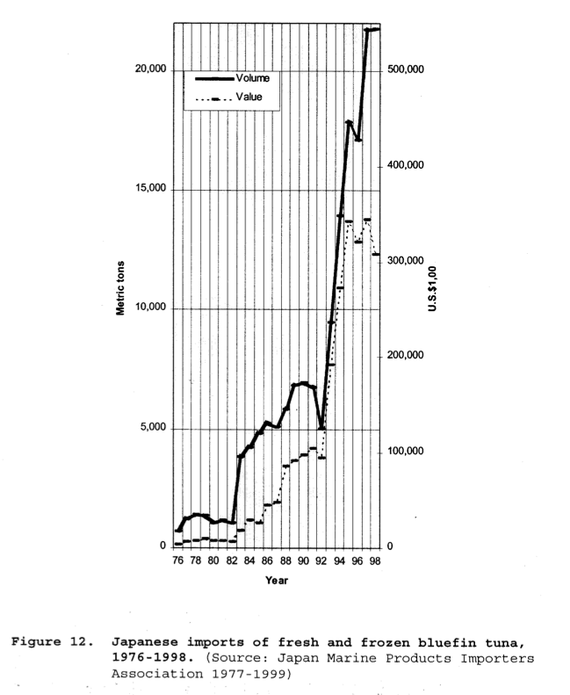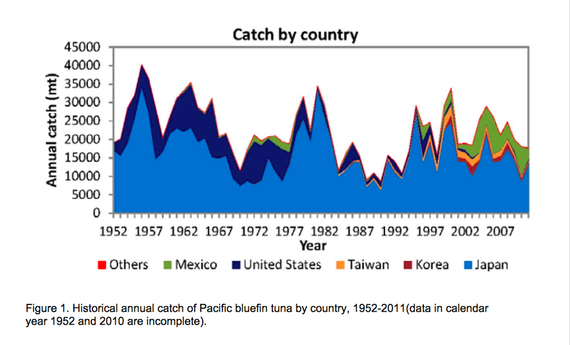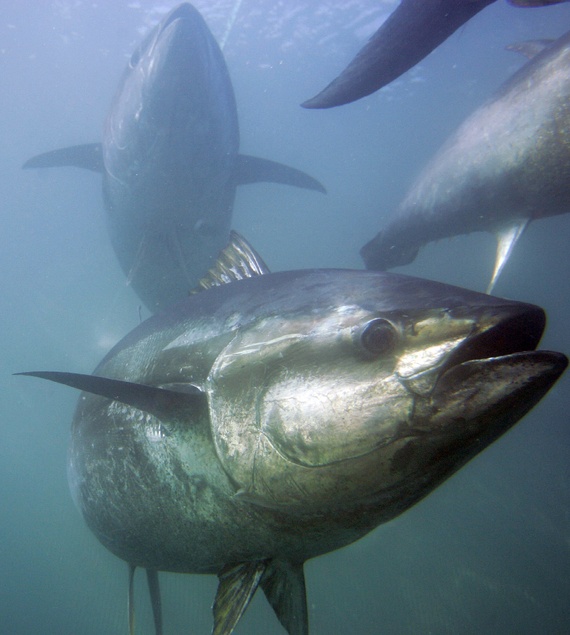Article Courtesy: theatlantic.com – Svati Kirsten Narulajan | Article originally published Jan 5, 2014 – please click here for original article.
There has been substantial discussion and comments about this article on the ROFFS™ Facebook page – please click here to read more (from April 10th, 2015).
Above: Kiyoshi Kimura paid a lot of money for this bluefin tuna, the first one auctioned off at the Tsukiji fish market in 2013. (Toru Hanai/Reuters)
Once used for cat food, the endangered fish is now one of the most prized delicacies in the world.
Every year, on the first Saturday in January, Japan makes a grand statement to the global fishing community by putting an exorbitant price on the head of a single bluefin tuna. At the famous Tsukiji fish market in Tokyo, the first bluefin auction of the year represents many things: growing consumer demand forbluefin sashimi, the exploitation of natural resources, the collapse of a species,shortsightedness in the face of impending doom to the entire ocean, a depravedpublicity stunt.
In 2013, Kiyoshi Kimura, the owner of a Japanese sushi restaurant chain, paid $1.76 million for the first bluefin at Tsukiji, which weighed 489 pounds. Kimura had paid $736,000—a world-record price at the time—for the first tuna of 2012. That fish weighed 593 pounds.
It’s no surprise, then, that journalists were steeling themselves for what was sure to come on January 4, 2014: If the past decade’s trend in pricing continued, this year’s first tuna would surely fetch more than a million dollars. But the Tsukiji fish market bucked tradition this weekend and sold its first tuna to Kimura, yet again, for a mere $70,000. That’s still way more money than most bluefin go for in Japan. But compared to what everyone was expecting—an extravagant sum to start off the new year and remind us that these are the most prized fish in the sea—that’s one crazy cheap tuna.
Although the significance of the almost-$2 million tuna in 2013 was recognized worldwide, not everyone agreed on what that said about the actual value of global tuna stocks. It was tempting to see the price surge as a function of the fish’s rarity, but then why weren’t restaurants raising the prices of the bluefin dishes on their menus?
Andrew David Thaler, who writes about the ocean on his blog Southern Fried Science, had this to say about the many factors at play in the Tsukiji auction last January:
I’m certain that we’ll see this number presented as an argument against bluefin tuna fishing, as an example of an industry out-of-control, and as a symbol of how ruthlessly we’ll hunt the last few members of a species to put on our dinner plates. These issues are reflected in the tuna market, but I want to urge caution in drawing too many conclusions from this record breaking number.
There are several issues in play at the first tuna auction of the year, and only some of them relate to the tuna fishery. Among the patrons of the Tsukiji fish auction, it is considered an honor to buy the first bluefin of the new years, and bidding wars reflect this fight for status. The massive international headlines that follow the purchase of such a fish is free advertising for the winner. As many auction-goers know, landing a high, early win is a way of marking your territory and letting your competitors know that you have the bankroll to push them out of a bidding war.
If $1.8 million is actually what this fish is worth to the consumer, it would sell for a hefty $345 at the dinner table, minimum. The owner, Kiyoshi Kimura, reports that the tuna will be sold at a huge loss–about $4.60 per serving.
All three species of bluefin tuna are currently overfished, and over the last few years attempts to protect bluefin tuna have been thwarted by fishing interests in Japan, New Zealand, the United States, and Mediterranean countries, among others. While this record breaking sale should serve a clarion call for increased scrutiny of the global tuna trade, it does not accurately reflect the market value of the fish.
What should we make of the dramatic nosedive in bluefin bidding at this year’s auction? To answer that, we need to understand how this species rose to such prestige in the first place.
In the 1960s, no one wanted bluefin. In the United States, the fish sold for pennies per pound, and it was usually ground up for cat food. Japan fished for it, but few people there liked the bluefin’s bloody, fatty meat. Then sushi bars started cropping up in America, and Americans developed a taste for toro—the prime meat of the bluefin’s belly. By the 1970s, the Japanese had also developed a taste for bluefin.
All of a sudden, bluefin was one of the most sought-after fish not only by Japanese fishermen but also by American and Canadian ones. According to theInternational Union for Conservation of Nature, between 1970 and 1990 fishing for bluefin in the Western Atlantic increased by more than 2,000 percent. The average price paid to Atlantic fishermen for bluefin exported to Japan rose by 10,000 percent. And it was mostly all being exported to Japan. Even today, a bluefin caught off the coast of New Hampshire will be shipped off to Tokyo before ending up on sushi plates somewhere else.
The graph above was published in a 2013 stock assessment by the International Scientific Committee for Tuna and Tuna-like Species in the North Pacific Ocean. It was this stock assessment that prompted The Pew Charitable Trusts to announce, just days after Kimura bought his tuna for $1.76 million, that global bluefin tuna stock has declined by 96.4 percent from pre-1950 levels.
That this year’s first tuna sold for $70,000 instead of $2 million could be a positive sign that the Japanese are more aware of the bluefin’s plight and no longer wish to call attention to their harvest—or it could mean that all is really lost for this fish, and people just don’t care how rare it is anymore.
Above image courtesy: Chris Park/Associated Press
There are a lot of numbers in this story, but when I think of bluefin tuna, I don’t see percentages or dollar signs. The first thing I ever learned about this fish came from reading Carl Safina’s book Song for the Blue Ocean. Not 500 words into Chapter One, Safina describes sighting a bluefin in the Atlantic:
What caught my eye was a faint chevron bulging ever so slightly from that molten, glassy sea, fifty yards from where I sat adrift. As I rose to my feet to study it, the chevron grew to a distinct wake. A wake without a boat. The wake ran along the surface for a few seconds, accelerated, and exploded like a revelation.
A giant bluefin tuna, among the largest and most magnificent of animals, hung suspended for a long, riveting moment, emblazoned and backlit like a saber-finned warrior from another world, until its six hundred pounds of muscle crashed into the ocean like a boulder falling from the sky. The jagged tear it left in the sea was marked by an emerald patch of fine bubbles rising slowly to the surface until the spot healed, slowly turned blue again, and became indistinguishable.
… Ashore, the vision of that giant tuna never dissipated.
I’ve never seen a bluefin, but Safina’s description of the fish has burned bright in my mind ever since I read that book.
There’s more. Safina flies over the Gulf of Maine one morning with a professional fish spotter, and they encounter a hundred of these tuna on the move:
About a hundred giant bluefin tuna are traveling peacefully just under the surface. The animals I am looking at are so large, I expect them to behave like dolphins; that they are not coming to the surface to breathe air feels somehow uncomfortable. I have to remind myself—it seems so odd—that these large creatures are truly fish.
Close your eyes. Think fish. Do you envision half a ton of laminated muscle rocketing through the sea as fast as you drive your automobile? Do you envision a peaceful warrior capable of killing you unintentionally with a whack of its tail? These giant tuna strain the concept of fish.
The giant tuna rise in unison, their backs breaking wakes like a flotilla of small boats. As they continue cruising, one of them splashes and sprints forward a few yards, like a thoroughbred jittery before a race, its behavior hinting strongly of enormous power in repose. What sense of the world, what feeling, moves this animal? Is it impatient? Is it thinking?
If you’re moved more by literature than by charts and graphs, like I am, but you don’t have access to Safina’s book, then another great way to learn about the bluefin is by reading this essay, by John Seabrook, published in Harper’smagazine in 1994. In “Death of a Giant,” Seabrook cites a $30,000 tuna as evidence that it’s the most valuable wild animal in the world. Twenty years later, prices are even higher—and the extinction Seabrook ponders is that much closer.









